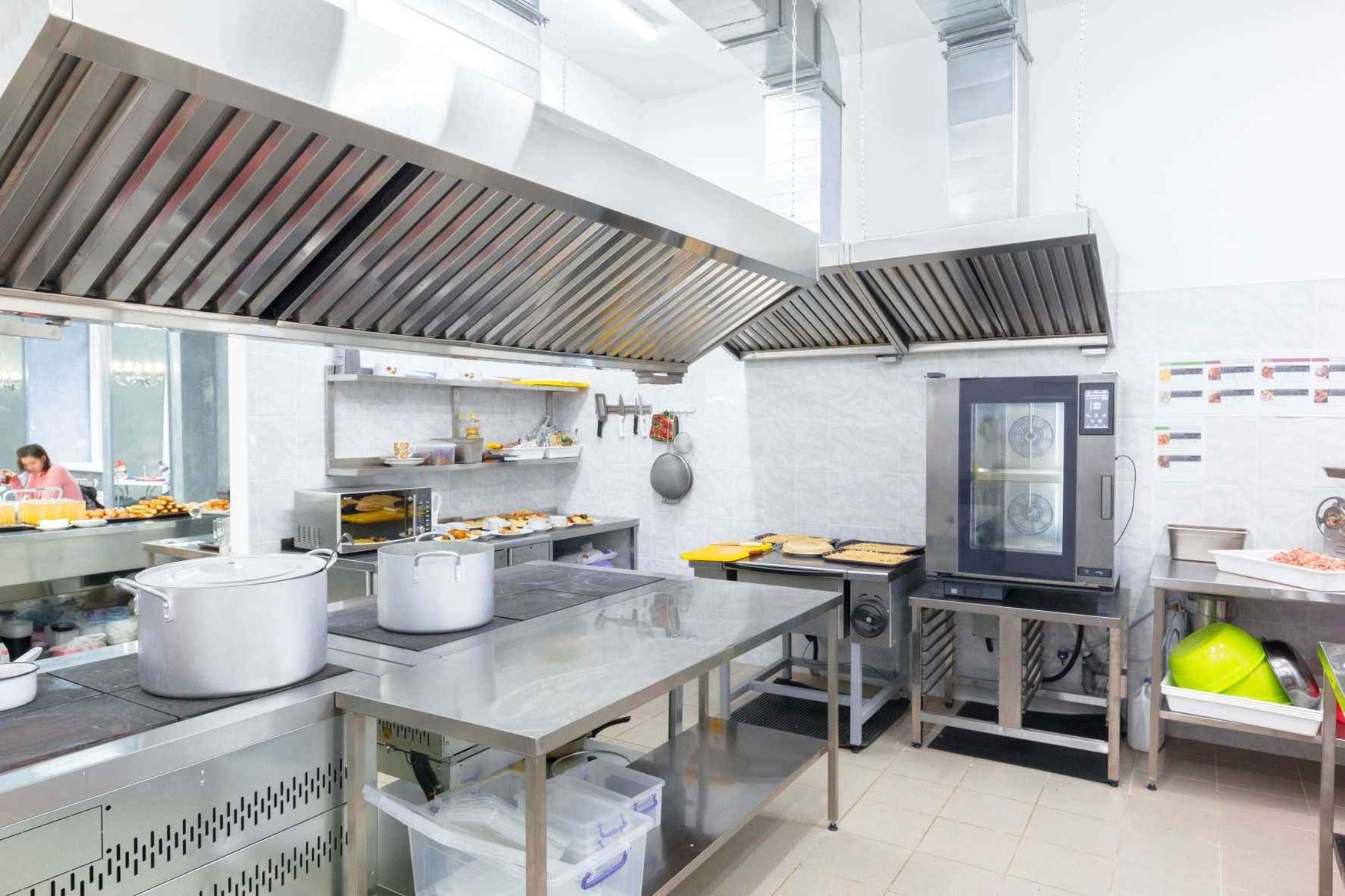Specifying Commercial Kitchen Hot Water Boosters in Chicago

Hot water boosters are now an integral part of commercial kitchens, anywhere in the US, including in Chicago. Before we describe the principal types of commercial kitchen hot water booster types available for commercial kitchen specification in Chicago, it’s important to understand several things including: the importance of hot water in commercial kitchens, the importance of commercial warewasher (or dishwasher) selection and its application, the prevailing regulatory context to hot water booster use, the value of heat pump technology, their location, features and benefits, design and sizing criteria.
The importance of hot water in commercial kitchens
It’s important to understand the critical components of food sanitation and ensure that the water heaters meet regulatory hot water requirements. Hot water is often used on a daily basis in a commercial kitchen and temperature plays a key role health and safety role.
Equipment Sanitation: Clean, sanitized equipment, dishware and surfaces reduces the risk of foodborne illness caused by bacteria that are invisible to the naked eye. The only way to ensure dishes are clean is to run them through a sanitizing warewasher, with either piping hot water or sanitizing chemicals.
Personal Hygiene: Personnel should be trained in proper personal hygiene for handling and serving food. It’s imperative that they know how to frequently and thoroughly wash their hands.
Cleaning Methods: ‘Best practice’ is to wipe down surfaces and equipment with clean cloths and detergent. A cloth soaked in hot or warm water is more effective than one that is cold and dirt or grease can be removed from hard floors more easily with hot water than cold.
Water temperature: Germs, bacteria and other microorganisms can't survive on ware heated to 160°F. It is understood that heating rinse water to 180°F will heat a dish surface of 160°F but it’s easier to heat a cold dish up to 160°F if it is pre-heated to 150-165°F. It’s critical however that a hot water sanitizing rinse cycle does not exceed 195°F, as food particles can fuse into dishware at that temperature.
The importance of commercial warewasher selection and its application
To comply with Chicago codes, commercial warewasher selection itself is important as it determines whether a hot water booster heater is desirable or not.
There are two main types of commercial warewashers with differing temperature requirements. Either a high-temp warewasher that uses hot water for sanitizing can be selected, or a low-temp warewasher, which requires chemicals.
Given hot water is desirable in commercial kitchens the former is preferable and is considered in more detail here.
A hot water sanitizing warewasher requires water to be run through the wash cycle be heated to 150-165°F, prior to a hot water sanitizing rinse cycle depending on the type of high-temp warewasher, typically at 180°F. A data plate affixed to a warewasher shows the temperature to be reached, as well as the time required for the wash cycle.
Regulatory Context of Commercial Kitchen Hot Water Boosters
The current edition of all applicable regulatory codes, including food, model plumbing and sanitation code applicable to Chicago, should always be consulted prior to specification, installation, repair, maintenance and operation of commercial kitchen hot water boosters. What follows here is for guidance purposes for commercial kitchen operators and owners.
US Food and Drug Administration Food Code
The US Food and Drug Administration (FDA) Food Code sets the health guidelines for Chicago, and defines the commercial kitchen hot water requirements outlined here:
Mechanical Warewasher: Wash Solution Temperature
Wash solution temperatures in spray-type warewashers using hot water to sanitize to be at least:
- 150°F: stationary rack, dual temperature machine and multitank, conveyor, multi-temperature machine
- 160°F: single tank, conveyor, dual temperature machine
- 165°F: stationary rack, single temperature machine
The rinse cycle is considered to be a sanitizing cycle, and during it water temperature should enter the machine at 180°F.
Mechanical Warewasher: Hot Water Sanitization Temperature.
Except as specified in this section, in a mechanical operation, the temperature of the fresh hot water sanitizing rinse as it enters the manifold is to be no more than 194°F:
- 165° F: stationary rack, single temperature machine
- 180°F: other machines
Despite temperature information provided in the Food Code and on washer equipment, periodic water temperature testing is recommended to ensure equipment functions properly.
When are booster heaters required?
If a hot water sanitizing method is deployed, a booster heater should be installed to safely reach the temperatures high enough to sanitize. A primary water heater thermostat may reach that level, but if used would cause severe burns when the hot water is used for anything else.
Heat Pump Technology
Heat pump technology removes heat from air where at a water heater location and transfers it to water via a refrigeration circuit. Researchers say that this technology could replace all electric resistance water heaters with the introduction of 160°F models. To achieve this detailed heater design, balancing the recovery rate with storage capacity, is required.
The benefits of heat pump technology is firstly, 'free' cooling provision and secondly, energy savings of around 50%.
Benefits of Commercial Kitchen Hot Water Boosters
The core benefits of commercial kitchen hot water boosters employing heat pump technology are that:
- They provide rapid self-drying and clean washware as high temperatures allow water to evaporate quickly once items are removed from a machine
- They ensure that final rinse water temperature is hot enough to meet codes
- Compact models are available
Commercial Kitchen Hot Water Booster Types
Commercial kitchen hot water boosters deliver high-volume sanitizing rinse water for commercial dishwashing operation. They are either high temperature, driven by heat pumps, or by conventional electrical means as low temperature, chemical sanitizing warewashers.
Unlike standard electrical water heaters, hot water booster heaters take water that is already warm and heat it to even higher temperatures between 180-195°F to properly rinse and sanitize washware and more in a commercial dishwasher.
Location, Features and Benefits of Heat-Pump driven Hot Water Boosters for Commercial Kitchens
Location: Heat pump hot water boosters are designed for use in commercial warewashers and form part of facilities with high water use occupancies, such as commercial kitchens (restaurants, hotels, nursing homes, hospitals included) where attention to food safety and public health is paramount.
Features:
Low water cut-off: Low water cut off prevents them from overheating by running dry. When paired with a leak detection sensor (standard on some models) it can alert an operator to a possible leak in the system, preventing water damage to the electrical components and the surrounding area.
Tank design: Some booster tanks are durable. There are two distinct types of tank styles available for them: cement lined steel and stainless steel. Both have their benefits but stainless steel tanks are the most durable and meet American Society of Mechanical Engineers (ASME) standards for the construction of boilers and pressure vessels. Compact models are also available.
Temperature: Heat pump booster heaters, or reverse cycle chillers, provide up to 180°F water (whereas standard hot water booster heaters electrically boost temperature from 120-140°F). ·They ensure that final rinse water temperature is hot enough to meet sanitation codes. They also provide rapid self-drying and clean dishware because high temperatures allow water to evaporate quickly once items are removed from the dishwasher. They also ensure that final rinse water temperature is hot enough to meet sanitation codes.
Temperature control/display: Boosters are generally easy to service. Some come with electronic controls and a digital temperature display to allow required warewashing machine water temperature to be set to meet code. Others have simple electromechanical controls and a standard output temperature of 180°F.
Hard Water: To prevent premature failure, check the water hardness requirements and ensure a booster is properly conditioned or filtered.
Benefits:
- Hot water demand can be accomplished efficiently.
- Energy savings for hot water are at least 20%
Booster Heater Sizing
To size a booster correctly, the following variables need to be defined:
· The temperature of the incoming water to a warewasher.
· The rise in temperature required.
-For high temperature warewashers, subtract the temperature of incoming water from 180°F.
-For low temperature warewashers, subtract the temperature of incoming water from 120°F.
· The gallons per hour of water used for the final rinse cycle.
To size a booster heater, for electric models, input the temperature and water usage data collected in this formula:
(water used GPH x desired temperature rise) / 400 = estimated kW
End Note:
The information provided here surrounding the context, value and specification of commercial kitchen hot water boosters, should orientate you but for further design, specification and sizing assistance to meet required codes professional engineers familiar with hot water booster application can be consulted.

Ankit Javeri
Ankit is the Project Manager at NY Engineers, who holds an M.Tech. Some of his projects includes Community Access, Jackson Avenue
Join 15,000+ Fellow Architects and Contractors
Get expert engineering tips straight to your inbox. Subscribe to the NY Engineers Blog below.


